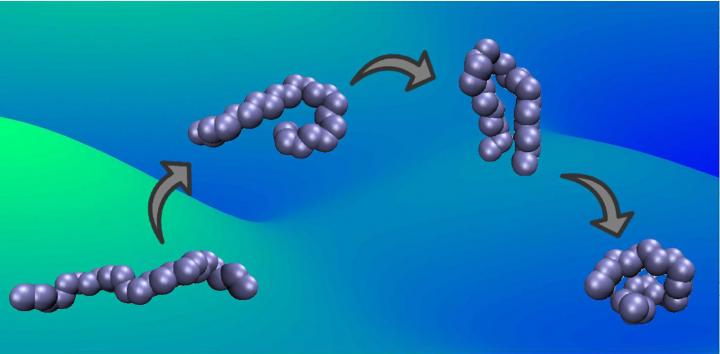Reconstructing folding funnels from experimental data to uncover proteins' inner life

The molecular folding funnel contains all of the stable molecular states and folding pathways between them, providing important information about structure and mechanisms that can reveal how a polymer or protein folds, or aid in the design of drug molecule or ligands with a particular shape. Credit: Andrew Ferguson, University of Illinois
“This work lays the foundations to recover the protein folding landscapes directly from experimental data, providing a route to new understanding and rational design of proteins,” explained Andrew Ferguson, an assistant professor of materials science and engineering at the University of Illinois at Urbana-Champaign.
“While we remain far from this goal, our understanding of protein folding was revolutionized by the 'new view' that envisages molecular folding as a conformational search over a funneled free energy surface.”
According to Ferguson, the single-molecule free energy surface encodes all of the thermodynamics and pathways of folding, dictating protein structure and dynamics. Each point on the landscape corresponds to an ensemble of similar protein conformations, and the height of the landscape prescribes their stability. It is a key goal of physical chemistry to determine molecular folding landscapes.
“Molecular folding landscapes can be inferred from long computer simulations in which the positions of all atoms in the molecule are known,” said Jiang Wang, a graduate research assistant and first author of the paper, “Nonlinear reconstruction of single-molecule free energy surfaces from univariate time series,” published in Physical Review E.
“Experimental techniques such as single molecule Förster resonance energy transfer (FRET) can measure distances between covalently-grafted fluorescent dye molecules to track the size of the molecule as a function of time, but it has so far not been possible to reconstruct folding funnels from experimental measurements of single coarse-grained observables,” Ferguson explained.
“In this work, we have integrated nonlinear machine learning and statistical thermodynamics with Takens' Theorem from dynamical systems theory to demonstrate in computer simulations of a hydrophobic polymer chain that it is possible to determine molecular folding landscapes from time series of a single experimentally-accessible observable.”
“The information loss associated with its reconstruction from a single observable means that the topography of the reconstructed funnel may be perturbed – the heights and depths of the free energy peaks and valleys may be altered – but it faithfully preserves the topology of the true funnel – the locality, continuity, and connectivity of molecular configurations,” Wang noted.
“This means that the folding funnel determined from a measurements of, in this case, the head-to-tail distance of the chain is geometrically and topologically identical and contains precisely the same molecular states and transition pathways as that computed from knowledge of all the atomic positions,” Ferguson added.
“We are very excited by this idealized proof of principle for computer simulations of a polymer chain, and are currently working to extend our analyses to simulations of biologically realistic peptides and proteins, and partner with single molecule biophysicists to apply our technique to experimental measurements of real proteins,” Ferguson said.
Media Contact
All latest news from the category: Life Sciences and Chemistry
Articles and reports from the Life Sciences and chemistry area deal with applied and basic research into modern biology, chemistry and human medicine.
Valuable information can be found on a range of life sciences fields including bacteriology, biochemistry, bionics, bioinformatics, biophysics, biotechnology, genetics, geobotany, human biology, marine biology, microbiology, molecular biology, cellular biology, zoology, bioinorganic chemistry, microchemistry and environmental chemistry.
Newest articles

NASA: Mystery of life’s handedness deepens
The mystery of why life uses molecules with specific orientations has deepened with a NASA-funded discovery that RNA — a key molecule thought to have potentially held the instructions for…

What are the effects of historic lithium mining on water quality?
Study reveals low levels of common contaminants but high levels of other elements in waters associated with an abandoned lithium mine. Lithium ore and mining waste from a historic lithium…

Quantum-inspired design boosts efficiency of heat-to-electricity conversion
Rice engineers take unconventional route to improving thermophotovoltaic systems. Researchers at Rice University have found a new way to improve a key element of thermophotovoltaic (TPV) systems, which convert heat…



